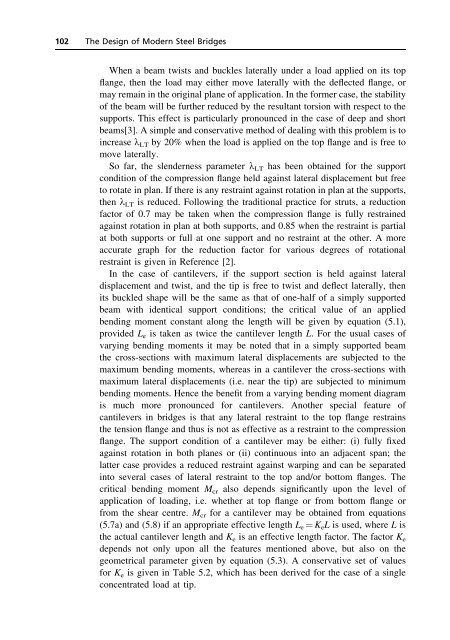The Design of Modern Steel Bridges - TEDI
The Design of Modern Steel Bridges - TEDI
The Design of Modern Steel Bridges - TEDI
Create successful ePaper yourself
Turn your PDF publications into a flip-book with our unique Google optimized e-Paper software.
102 <strong>The</strong> <strong>Design</strong> <strong>of</strong> <strong>Modern</strong> <strong>Steel</strong> <strong>Bridges</strong><br />
When a beam twists and buckles laterally under a load applied on its top<br />
flange, then the load may either move laterally with the deflected flange, or<br />
may remain in the original plane <strong>of</strong> application. In the former case, the stability<br />
<strong>of</strong> the beam will be further reduced by the resultant torsion with respect to the<br />
supports. This effect is particularly pronounced in the case <strong>of</strong> deep and short<br />
beams[3]. A simple and conservative method <strong>of</strong> dealing with this problem is to<br />
increase l LT by 20% when the load is applied on the top flange and is free to<br />
move laterally.<br />
So far, the slenderness parameter l LT has been obtained for the support<br />
condition <strong>of</strong> the compression flange held against lateral displacement but free<br />
to rotate in plan. If there is any restraint against rotation in plan at the supports,<br />
then l LT is reduced. Following the traditional practice for struts, a reduction<br />
factor <strong>of</strong> 0.7 may be taken when the compression flange is fully restrained<br />
against rotation in plan at both supports, and 0.85 when the restraint is partial<br />
at both supports or full at one support and no restraint at the other. A more<br />
accurate graph for the reduction factor for various degrees <strong>of</strong> rotational<br />
restraint is given in Reference [2].<br />
In the case <strong>of</strong> cantilevers, if the support section is held against lateral<br />
displacement and twist, and the tip is free to twist and deflect laterally, then<br />
its buckled shape will be the same as that <strong>of</strong> one-half <strong>of</strong> a simply supported<br />
beam with identical support conditions; the critical value <strong>of</strong> an applied<br />
bending moment constant along the length will be given by equation (5.1),<br />
provided L e is taken as twice the cantilever length L. For the usual cases <strong>of</strong><br />
varying bending moments it may be noted that in a simply supported beam<br />
the cross-sections with maximum lateral displacements are subjected to the<br />
maximum bending moments, whereas in a cantilever the cross-sections with<br />
maximum lateral displacements (i.e. near the tip) are subjected to minimum<br />
bending moments. Hence the benefit from a varying bending moment diagram<br />
is much more pronounced for cantilevers. Another special feature <strong>of</strong><br />
cantilevers in bridges is that any lateral restraint to the top flange restrains<br />
the tension flange and thus is not as effective as a restraint to the compression<br />
flange. <strong>The</strong> support condition <strong>of</strong> a cantilever may be either: (i) fully fixed<br />
against rotation in both planes or (ii) continuous into an adjacent span; the<br />
latter case provides a reduced restraint against warping and can be separated<br />
into several cases <strong>of</strong> lateral restraint to the top and/or bottom flanges. <strong>The</strong><br />
critical bending moment M cr also depends significantly upon the level <strong>of</strong><br />
application <strong>of</strong> loading, i.e. whether at top flange or from bottom flange or<br />
from the shear centre. M cr for a cantilever may be obtained from equations<br />
(5.7a) and (5.8) if an appropriate effective length Le ¼ KeL is used, where L is<br />
the actual cantilever length and K e is an effective length factor. <strong>The</strong> factor K e<br />
depends not only upon all the features mentioned above, but also on the<br />
geometrical parameter given by equation (5.3). A conservative set <strong>of</strong> values<br />
for K e is given in Table 5.2, which has been derived for the case <strong>of</strong> a single<br />
concentrated load at tip.


